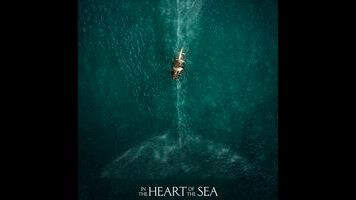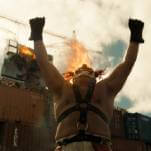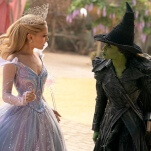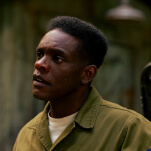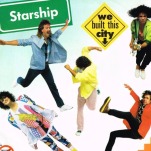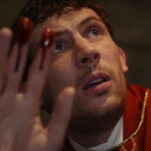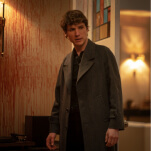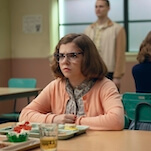Herman Melville, onetime sailor, never set foot on Nantucket before publishing Moby-Dick, but in In The Heart Of The Sea—which adapts Nathaniel Philbrick’s non-fiction book about the Essex whaleship disaster as a hokey origin story for Melville’s novel—he arrives on the island, hoping to find the man who had been the Essex’s cabin boy and turn his account of a ship rammed by a sperm whale into a book. The man in question, Thomas Nickerson, is only supposed to be in his mid-40s at this point, but this being the rough times of the 19th century, he has prematurely aged into a gruff, cranky Brendan Gleeson. And so, as Melville (Ben Whishaw) scratches away at paper with his mother-of-pearl pen, Nickerson yammers out his story about a journey to that part of the sea “where knowledge ended, and speculation began,” and of vindictive whales, one-armed Spaniards, and sailors forced to resort to cannibalism.
Scripted by Charles Leavitt (Blood Diamond, K-Pax), In The Heart Of The Sea is utterly bogus as a re-telling of the Essex story—which did provide some inspiration for Moby-Dick—and as a commentary on Melville’s classic, and downright ravishing as a vision of the sea, drawing on two centuries of maritime art, from J.M.W. Turner’s paintings to Lucien Castaing-Taylor and Véréna Paravel’s documentary Leviathan. So visually busy and creatively confident that you’d hardly believe Ron Howard directed it, the movie churns with color-scape skies and abstracted cuts to strained riggings and whale viscera, while murky waters and old glass make ripples in the foreground of the 3-D frame. Whalers’ faces are flecked by jets of blood after a harpooning, a flintlock sinks into the ocean after a sailor’s suicide, Melville’s pen dips into an inkwell like an anchor ripping into seabed—if In The Heart Of The Sea has its share of clunks and groans, it also looks suspiciously like bona fide big-screen art.
In what could be called the “1990s Mel Gibson role,” Chris Hemsworth plays first mate Owen Chase, who is passed over for a promised captaincy in favor of the untested George Pollard (Benjamin Walker), causing a rivalry. (In real life, the two had served together for years on the Essex before being promoted, though this change is relatively small for a movie whose ending makes A Beautiful Mind seem factual in comparison.) From here, the audience is introduced to the rest of the crew, including second mate Matthew Joy (Cillian Murphy, in a limited but poignant role), the adolescent Thomas Nickerson (Tom Holland), and Pollard’s portentously named cousin, Owen Coffin (Frank Dillane), re-christened “Henry” because no two characters in a movie can have the same first name.
Hit early on by a squall—which begins as a painterly smear before swelling into extravagant waves of effects—the Essex finds itself still short of its sperm whale quota a year later, and sails for an unmapped part of the Pacific, where it will be rammed and sunk, forcing the survivors to spend months at sea. Leavitt’s screenplay chucks out much of what’s weird about the Essex story (say, the bit where the crew caused the extinction of a tortoise species by accidentally setting an island on fire) in favor of a mushy hubris parable, outfitted with a corny subplot about a corporate cover-up. It doesn’t matter a whole lot, given how Howard and cinematographer Anthony Dod Mantle mainline the inherent drama of the sea.
Here, Turner-esque horizons hover behind decks bloody with sperm whale brain matter, and a man swims from a burning shipwreck carrying muskets—bluntly symbolic of both violence and ingenuity—while fire and water, both elemental forces, square off behind him. Disorienting tight shots (a harpoon line wrapping around a sperm whale’s tail, a figure with bowling-ball breasts being carved in scrimshaw, a dead whale’s eye reflecting men á la Werckmeister Harmonies, etc.) punctuate matte-painting-like digital vistas, creating a constantly swaying sense of scale, as though the whole movie were being continually rocked by a storm of artistic impulses. Which is to say that, even though In The Heart Of The Sea’s framing device often feels like it was written by someone who’d never read a word of Melville, its visual style makes for a bold approximation of his allusive prose.
Howard, an often proficient director of mostly good-looking movies, hasn’t shown this much ambition since Far And Away, a movie that similarly took inspiration from the kind of sweeping hokum Hollywood used to do well. The difference with his new film is that its 1950s luster is in competition with an impressionistic palette of close-ups, creating a dynamic. Sometimes—as in the introduction of the older Nickerson, seated under a ceiling hung with hundreds of empty glass jugs—In The Heart Of The Sea seems to speak the language of visual simile and metaphor that defined the last years of silent film. Perhaps it’s best seen with a mental mute button.
